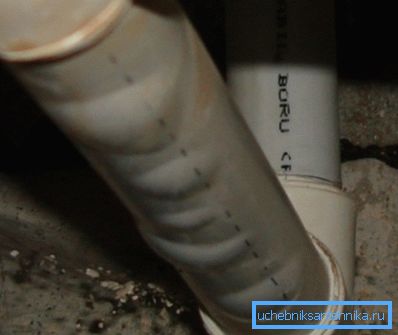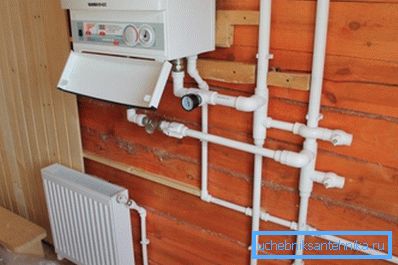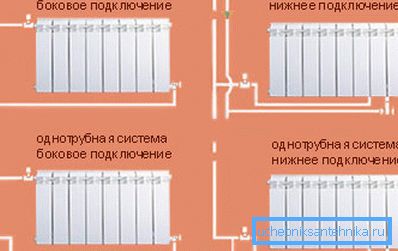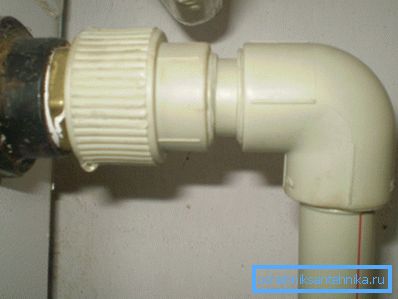Heating pipes made of polypropylene and everything connected
In this article we will talk about what are the pipes for heating of polypropylene, how they are made and what are the features of their use. Heating systems are still being built using various traditional materials, including a variety of metal alloys.
But despite this, polymer pipelines are becoming increasingly popular. And for this there are many obvious reasons, among which is an acceptable price and a lower probability of blockages.

Characteristics of production materials
Before we talk about pipes, consider the main characteristics of the production material used in their manufacture. After all, these qualities provide numerous advantages inherent in heating systems.
Polypropylene (PP) is a thermoplastic polymerized propylene. The material is manufactured in a production environment similar to those in which low-pressure polyethylene (HDPE) is produced. The difference in the type of polymer composition is determined by the type of catalyst used.
Polypropylene used in the production of plumbing accessories is a white powder or granules with a density of up to 0.5 g / cm ?. Depending on the production technology, PP is available in white or colored.
The material is characterized by a higher melting point than the temperature characteristic of polyethylene. In addition, polypropylene is more dense and, as a consequence, greater compressive and tensile strength.
Characteristics of PP pipes

Modern pipes made of polypropylene for heating are characterized by such qualities as:
- affordable price, which is explained not only by the cheapness of the production material, but also by the use in the manufacture of recycled materials;
- perfectly smooth surface of the inner walls and, as a result, the low probability of clogging in pipes;
- ease of machining and, as a result, the lack of difficulties with the installation;
- high temperature resistance transported medium;
- the possibility of laying water pipe into the wall;
- durability of the finished system no need for regular maintenance;
- Polypropylene pipe fitness for work with most modern heating devices.
Manufacturing features

Industrial production of PP pipes is performed by extrusion of molten material, due to which the finished products are characterized by a high degree of weldability. PP fittings and valves are manufactured by injection molding. Cast fittings are manufactured exclusively for pressure pipes labeled PN20.
In order to provide higher pipe strength, polypropylene can be reinforced with one or another mechanical deformation-resistant materials, such as foil.

Among the most common types of PP pipes, we note the following modifications:
- "RRV" - this marking is applied to products with high resistance to mechanical loads. As a rule, products with such markings are purchased for laying in a concrete screed for the installation of “Heat-insulated floor” systems.
- “PPH” - products with this marking are not intended for use in heating systems, as they are not adapted to high temperatures. Products with such markings are characterized by a large internal diameter, and therefore are used for arranging ventilation systems or main water pipelines.
- "PPR" is a universal and most common product. Products with such marking are equally suitable for transporting hot and cold water.
Modern PP pipes are represented on the market with the following brands:
- PN 20 - products are intended for the device of systems of a central heating and hot water supply;
- PN 20 (Stabi) - products are designed to create heating and plumbing systems with high pressure of the transported medium;
- PN 16 - products with the same success are used for arranging central heating and floor heating systems;
- PN 10 - products are used primarily for the installation of cold water systems.
- Therm - products are specially manufactured for use in heating systems.
Polypropylene pipe, reinforced with aluminum foil

If you are interested in assembling a heating system whose operational life exceeds 50 years, you need special reinforced PP pipes.
Such products are made using static copolymers of polypropylene with a characteristic gray tint. As a reinforcing layer, aluminum foil is most often used, which simultaneously strengthens the design of pipes, but does not reduce the degree of elasticity of the product. Less often fiberglass is used as a reinforcing layer.
In order to eliminate the development of corrosive processes, the reinforcing layer is enclosed between the outer and inner layer of polypropylene. Therefore, reinforced pipes can be used not only for the installation of heating systems in country houses, but also for connecting to the central system in the apartment.
Heating device diagrams

Before we tell you what the installation instructions are, consider the principle on which heating systems are installed using PP pipes.
Most of the current schemes today involve one-pipe or two-pipe connection with horizontal and vertical risers.
Among the most popular schemes, we note heating systems made:
- with the lower and upper liner (the choice of liner is determined by the location of the riser from which hot water is supplied);
- one-pipe or two-pipe scheme (in accordance with the option of connecting the system to the supply riser);
- with the associated movement of water in the pipeline and with a dead-end (closed) scheme (in accordance with the layout of the pipeline).
Important: In most modern construction projects, heating is built on the two-pipe principle. This scheme guarantees a number of advantages, among which we especially note the convenience of monitoring the temperature in the room. For example, with a one-pipe system, all radiators heat the same, whereas the two-pipe scheme allows shutting off the supply on the first radiator without affecting the operation of the following batteries.
Installation technology

Installation instructions are largely determined by the type of fittings used. Today, two types of fittings are used, namely, the collet version and welded products.
What to choose to build a domestic heating system?
- Collet connection is quite strong, and in addition, can be performed without the use of special tools. But this type of compound is characterized by insufficiently attractive appearance and fragility.
- Welded fittings provide a stronger, more durable and, importantly, inexpensive connection. In addition, the system assembled on welded joints, looks much more attractive.
Important: To use a welded pipe fitting, you will need a special soldering iron and related accessories, the price of which will increase the cost of the finished result.
So, despite the fact that the purchase of a soldering iron will have to fork out, let’s focus on the welded version of the installation.

The instruction of work is phased and simple:
- At the first stage, a system diagram is drawn up with an indication of the required pipe sizes and configuration of fittings.
- Further, all components are purchased in accordance with the scheme.
Important: The pipes are not cut immediately, but in the course of the welding work, as an error can be detected in the preliminary calculations.
- The pipeline is conducted from the point of water supply, that is, from the riser or from the heater.
- Pipes before welding are cut with special scissors and wiped from dirt.
- Next, the pipes and fittings are heated by a soldering iron to the melting temperature and are connected in a whole unit.
- The welded elements of the pipeline can be fixed with clips only after the joint has completely cooled down (about 10 minutes).
Conclusion
So, we found out how pipes for heating from polypropylene are produced and used for their intended purpose. In addition, we considered the types of these products on the market and what is better to choose for installation with your own hands.
Have any questions? You can find more useful information by watching the video in this article.